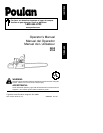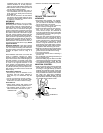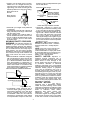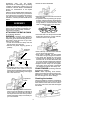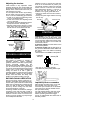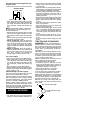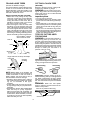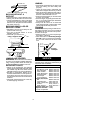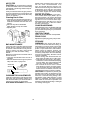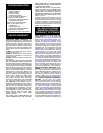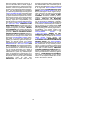
7
For cold engineor warmengine afterrun-
ning out of fuel.
S
Pull the choke lever out to the full extent.
OFF FULL
CHOKE LEVER
Choke Lever
(SIDE VIEW)
S
Press the throttle lockout with your right
hand. Squeeze and hold the throttle trig-
ger; Press and hold the fast idle lock with
your forefinger; release the throttle trig-
ger.
NOTE
:
If the throttle trigger is squeezed
during starting, it will be necessary to re-
set the fast idle lock.
S
Pull the starter rope quickly with yourright
hand until the engine attempts to start,
then push the choke lever to the half posi-
tion.
S
Pull the starter rope quickly with yourright
hand until the engine starts.
S
Above 40 degrees,
allow the engine to
run for approximately five seconds, then
push the choke knob to the off position.
Then, squeeze and release the throttle
trigger to release the fastidle, allowing the
engine to idle.
S
Below 40 degrees,
allow the engine to
warm up30 seconds to one minute at half
choke. Push choke knob to the off posi-
tion; Then, squeeze and release the
throttle trigger to allow engine to idle.
For a warm engine:
S
Move on/stop switch to the
ON
position.
S
Press the throttle lockout with your right
hand. Squeeze and hold the throttle trig-
ger; Press and hold the fast idle lock with
your forefinger; release the throttle trig-
ger.
S
Be sure choke is in the
OFF
position.
S
Pull the starter handle until engine starts.
S
Squeeze and release the throttle trigger to
allow engine to idle.
Difficult starting or flooded engine:
The engine may be flooded with too much
fuel if it has not started after 10 pulls.
Flooded engines can be cleared of excess
fuel by following the warm engine starting
procedure listed above. Insure the ignition
switch is in the
ON
or
START
position.
Starting could require pulling the starter
rope handle many times depending onhow
badly the unit is flooded. If engine fails to
start referto the troubleshooting chart orcall
your Authorized Service Dealer.
CUTTING METHODS
IMPORTANT POINTS
S
Cut wood on ly. D o not cu t metal, plastics,
masonry , non-wood building materials, etc.
S
Stop the saw if the chain strikes a foreign
object. Inspect the saw and repair parts
as necessary.
S
Keep the chain out of dirt and sand. Even a
small amount of dirt will quickly dull a chain
and increase the possibility of kickback.
S
Practice cutting afew small logs using the
following techniques to get the “feel” of
using your saw before you begin a major
sawing operation.
S
Squeeze the throttle trigger and allow the
engine to reach full speed before cutting.
S
Begin cutting with the saw frame against
the log.
S
Keep the engine at full speed the e ntire
time you are cutting.
S
Allow the chain to cut for you. Exert only
light downward pressure.
S
Release the throttle trigger as soon as the
cut is completed, allowing the engine to
idle. If you run the saw at full throttle with-
out acutting load, unnecessary wear can
occur.
S
To avoid losing control when cut is com-
plete, do not put pressure on saw at end
of cut.
S
Stop the engine before setting the saw
down.
TREE FELLING TECHNIQUES
WARNING:
Do not cut near buildings or
electrical wires if you do not know the direc-
tion of tree fall, at night since you will not be
able to see well, or duringbadweather such
as rain, snow, or strong winds. as fa ll is un-
predictable.
Carefully plan your sawing operation in ad-
vance. You need aclear area all around the
tree so you can have secure f ooting. Check
for broken or dead branches which can fall
on you causing serious injury.
Natural conditions that can cause a tree to
fall i n a particular direction include:
S
The wind direction and speed.
S
The lean of the tree. The lean of a tree
might not be apparent due to uneven or
sloping terrain. Use aplumb orlevel to de-
termine the direction of tree lean.
S
Weight and branches on one side.
S
Surrounding trees and obstacles.
Look for decay and rot.Ifthe trunk isrotted,
it can snap and fall toward the operator.
Make sure there is enoughroom forthe tree to
fa ll. Mainta in a dista n c e of
2- 1 / 2
tree length s
fr om the nea rest person or other ob j ects. En-
gine noise can drown out a warning call.
Remove dirt, stones, loose bark, nails, sta-
ples, and wire from the tree where cuts are
to be made.
Direction of Fall
45
_
Plan a clear retreat path



